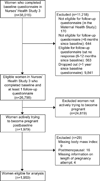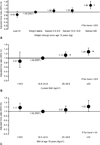Association of Fecundity With Changes in Adult Female Weight
- PMID: 26348178
- PMCID: PMC4580510
- DOI: 10.1097/AOG.0000000000001030
Association of Fecundity With Changes in Adult Female Weight
Abstract
Objective: To evaluate whether weight change since age 18 years, current body mass index (BMI), and BMI at age 18 years are associated with fecundity.
Methods: Our study included 1,950 women in the Nurses' Health Study 3 (2010-2014), a prospective cohort study, currently attempting pregnancy. Height, current weight, and weight at age 18 years were self-reported on the baseline questionnaire. Every 3-6 months thereafter, women reported the current duration of their pregnancy attempt. Multivariable-accelerated failure time models were used to estimate the time ratios and 95% confidence intervals (CIs).
Results: For every 5-kg increase in body weight from age 18 years, current duration of pregnancy attempt increased by 5% (95% CI 3-7%). Compared with women who maintained weight, the adjusted median current duration was 0.5 months shorter in those who lost weight, 0.3 months longer for those who gained 4-9.9 kg and 10-19.9 kg, and 1.4 months longer for those who gained 20 kg or more (P trend ≤.001). The adjusted time ratio (95% CI) for a 5-kg/m increase in current BMI was 1.08 (1.04-1.12). After multivariable adjustment (including adjustment for current BMI), being underweight at age 18 years (BMI less than 18.5) was associated with a longer current duration of pregnancy attempt compared with normal-weight women (time ratio 1.25, 95% CI 1.07-1.47); however, being overweight or obese at age 18 years was not associated with fecundity.
Conclusion: Gaining weight in adulthood, being overweight or obese in adulthood, and being underweight at age 18 years were associated with a modest reduction in fecundity.
Level of evidence: II.
Conflict of interest statement
Figures



Comment in
-
Association of Fecundity With Changes in Adult Female Weight.Obstet Gynecol. 2016 Jan;127(1):161-162. doi: 10.1097/AOG.0000000000001220. Obstet Gynecol. 2016. Retraction in: Obstet Gynecol. 2021 Aug 1;138(2):312. doi: 10.1097/AOG.0000000000004496. PMID: 26695565 Retracted. No abstract available.
-
In Reply.Obstet Gynecol. 2016 Jan;127(1):162-163. doi: 10.1097/AOG.0000000000001221. Obstet Gynecol. 2016. PMID: 26695566 No abstract available.
References
-
- Nelson SM, Fleming R. Obesity and reproduction: impact and interventions. Curr Opin Obstet Gynecol. 2007;19:384–389. - PubMed
-
- Sim KA, Partridge SR, Sainsbury A. Does weight loss in overweight or obese women improve fertility treatment outcomes? A systematic review. Obes Rev. 2014;15:839–850. - PubMed
-
- Ramlau-Hansen CH, Thulstrup AM, Nohr EA, Bonde JP, Sorensen TI, Olsen J. Subfecundity in overweight and obese couples. Hum Reprod. 2007;22:1634–1637. - PubMed
Publication types
MeSH terms
Grants and funding
LinkOut - more resources
Full Text Sources
Research Materials

